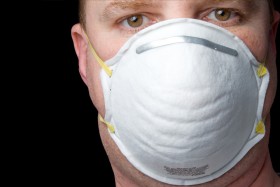OSHA and NIOSH Issue Alert to Protect Workers from Silica in Stone Countertops

On February 18th, the Occupational Health and Safety Administration (OSHA) and the National Institute for Occupational Safety and Health (NIOSH) have issued a hazard alert regarding exposure to silica during the manufacture and installation of stone countertops. They have identified exposure to crystalline silica as a hazard people who work in manufacturing, finishing, and installing stone countertops need to be protected from.
The alert comes after 46 workers in Spain and 25 workers in Israel developed silicosis as a result of their work either manufacturing or installing stone countertops. 10 of the workers in Israel needed to have lung transplants as a result of the disease. In some of the cases in Spain and Israel, the workers were working in shops without adequate respiratory protection or dust suppression systems. Efforts to control crystalline silica dust exposure have been made in the United States, but OSHA and NIOSH are concerned that exposure isn’t being controlled enough in some worksites.
It you have a stone countertop at home, don’t worry: having finished stone countertop isn’t inherently dangerous. The hazard lies in being exposed to the crystalline silica particles that become airborne when the stone is ground, polished, chipped, sanded, drilled, or cut during the manufacturing, finishing, and installation processes.
Silicosis is an incurable and sometimes fatal lung disease caused by inhaling miniscule particles of crystalline silica. When inhaled, crystalline silica particles are extremely damaging to lung tissue. Particles get stuck in lung tissue and cause inflammation and scarring, making it more difficult for lungs to take in oxygen. Exposure to airborne crystalline silica particles also increases the risk of lung cancer, lung infections, kidney disease, and chronic obstructive pulmonary disease (COPD).
Symptoms of silicosis include extreme shortness of breath, fatigue, coughing, and weight loss. There are three different types of silicosis: acute silicosis, accelerated silicosis, and chronic silicosis. Acute silicosis develops between a few months and two years of very high exposure to crystalline silica particles. Accelerated silicosis occurs after 5-10 years of high crystalline silica particle exposure and chronic silicosis comes can come after 15-20 years of low or moderate exposure to crystalline silica particles.
Crystalline silica occurs naturally as quartz in sandstone, quartzite, granite, and various other types of rock and sand. It has been labeled as carcinogenic to human lungs. Although this alert only pertains to the stone countertop industry, people who work in shipyards, tunneling, foundry, rock drilling, well drilling, concrete mixing, and brick cutting are also at risk of being exposed to crystalline silica on the job. With all industries considered, about 2 million people face a serious risk of being exposed to crystalline silica on the job.
The alert issued by OSHA and NIOSH provides recommendations of ways employers can keep workers safe on the job. Some of their recommendations include monitoring air quality, providing respiratory protection, and using engineering controls and work practices to minimize exposure to crystalline silica. When installing stone countertops in residential homes, it’s advisable to do as much work as possible outdoors or in a properly ventilated area, use tools equipped with dust shrouds, and to use a HEPA-filtered vacuum cleaner to clean up any dust.
Our personal injury attorneys at the Law Offices of Goodwin & Scieszka handle a wide array of work-related injury cases, such as: unsafe workplace cases and workers compensation claims. Contact us to see how we can help you receive fair compensation.






